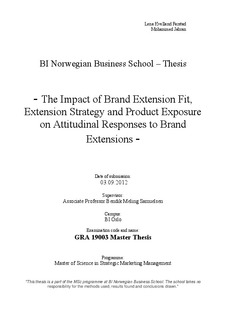The impact of brand extension fit, extension strategy and product exposure on attitudinal responses to brand extensions
Master thesis
Permanent lenke
http://hdl.handle.net/11250/94831Utgivelsesdato
2013-02-08Metadata
Vis full innførselSamlinger
- Master of Science [1621]
Sammendrag
Brand extensions have for decades been one of the most used strategies for growth, but the sad reality is that 8 out of 10 extensions fail, making the likelihood of failure unattractively high. In addition, competition and pressure on margins increases as retailers’ power improves due to proliferation of private labels. As a result, managers are eager for new innovative strategies that can differentiate their extension and improve likelihood of success. The purpose of this paper is therefore to present an innovation in the brand extension field, enabling managers to introduce extensions with greater chances of success. More specifically, the paper will investigate how extensions in alliance with retailers can create benefits that would otherwise be impossible for the manufacturer to obtain alone. These alliances can yield important benefits such as attractive shelf-space, shared introduction costs, shared risk, and increased likelihood of being one of very few extension successes. In addition, these collaborations might result in closer retailer-relationships that may benefit other products in manufacturers’ portfolio. To test these new strategies, two studies with an experimental research design were created. The first study examined how extension strategy affects the relationship between brand extension fit and attitude towards the extension product. Though main effects of fit and store image were confirmed, it was not possible to conclude that the effect of brand extension fit on attitude toward extension product was moderated by extension strategy. This does not mean that managers can disregard how extension strategies affect fit. Grocery stores’ image might not yet inhabit enough product-specific attributes to affect an extension product more positively. However, as it was found that extending to a category with a high-end retailer did not detract consumers’ attitudes such alliances might be beneficial when risk of extending alone is perceived as high. n many cases, the only available retailer that a manufacturer can partner up with is a low-end retailer. In these instances, it is important for managers to know how they can improve attitudes toward extension products, given these circumstances. The second study investigates how increasing exposures of a low fit extension can result in more favorable attitudes, making such extension strategies more successful. The analysis showed that in the no repeated exposure condition, a significant difference between low- and high fit exists. In the repeated exposure condition however, no such difference exists. Consequently, managers should increase frequency of marketing activities when promoting a low fit extension product co-produced with a low-end retailer in order to increase the likelihood of favorable attitudes and success.
Beskrivelse
Masteroppgave(MSc) in Master of Science in Strategic Marketing Management - Handelshøyskolen BI, 2013
